The Darwin Awards Countdown to Extinction (20 page)
Read The Darwin Awards Countdown to Extinction Online
Authors: Wendy Northcutt
Pseudogenes are a
big
chunk of our genome: We have an estimated 25,000 protein-coding genes and 20,000 pseudogenes. Pseudogenes are almost as common as genes!
big
chunk of our genome: We have an estimated 25,000 protein-coding genes and 20,000 pseudogenes. Pseudogenes are almost as common as genes!
Pseudogenes and the Blight of Scurvy
Pseudogenes provide a fossil record of how the modern genome came to be. Here’s an example:
Most animals make their own vitamin C. Humans cannot. We have to eat vitamin C-rich food or suffer the blight of scurvy.
Scientists traced this human disease to
a single pseudogene,
the broken remains of a gene that once enabled our ancestors to synthesize vitamin C
.
Pretty neat, huh? They found the fossil remains of the very gene that enabled our furry forefathers to synthesize vitamin C. The gene stopped working approximately 40 million years ago; since then its pseudogene fossil has been perched on chromosome 8, quietly accumulating random mutations.
a single pseudogene,
the broken remains of a gene that once enabled our ancestors to synthesize vitamin C
.
Pretty neat, huh? They found the fossil remains of the very gene that enabled our furry forefathers to synthesize vitamin C. The gene stopped working approximately 40 million years ago; since then its pseudogene fossil has been perched on chromosome 8, quietly accumulating random mutations.
At the time we lost the vitamin C gene, any individual that avoided vitamin C-rich foods such as citrus would die. That’s what happens when natural selection is operating on a species: A large number of people without the necessary gene or attribute die before they can reproduce. All surviving animals were genetically wired (and perhaps culturally inclined) to eat juicy oranges and pineapple and tomatoes and so forth.
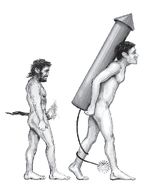
Retired Pseudogene Caught Working
It’s not easy to be sure that a gene is inactive. Some so-called pseudogenes are actually pretty busy. Research in pond snails and mice shows that some stretches of DNA formerly labeled pseudogenes are actually transcribed into RNA that regulates their protein counterparts. One of these was discovered accidentally in the course of genetically engineering lab mice.
Researchers inserted a gene sequence into a mouse pseudogene (
Makorin1-p1
) intended as a control—a blank—nothing should happen. But to the scientists’ surprise, the resulting babies died, for the most part. The few survivors displayed terrible deformities: Bones cells were laid out wrong, leading to weak and brittle skeletons. Multiple cysts grew on their kidneys and livers. And they had skin defects—for instance, the epithelium that covers the embryos’ eyes didn’t form properly, so their eyes were open in the womb.
Makorin1-p1
) intended as a control—a blank—nothing should happen. But to the scientists’ surprise, the resulting babies died, for the most part. The few survivors displayed terrible deformities: Bones cells were laid out wrong, leading to weak and brittle skeletons. Multiple cysts grew on their kidneys and livers. And they had skin defects—for instance, the epithelium that covers the embryos’ eyes didn’t form properly, so their eyes were open in the womb.
Why was the disruption of the pseudogene so catastrophic?
Recall that a gene is a sequence of DNA, and its DNA is transcribed into many RNA copies, which are templates for building a protein. Knocking out the pseudogene is catastrophic, the researcher hypothesized, because the pseudogene is still being transcribed into RNA but the cell does not use it to build a protein. Instead, the pseudogene RNA seems to stabilize the transcription of the nearby working gene (aptly named
Makorin1
). Knocking out the
stabilizing
pseudogene impairs the mouse’s ability to make the
Makorin1
protein.
Makorin1
). Knocking out the
stabilizing
pseudogene impairs the mouse’s ability to make the
Makorin1
protein.
Darwin himself noted that a vestigial structure could be useless for its primary anatomical function, but retain a secondary anatomical role.
Makorin1-p1
is the broken remnant of a once-functional gene, but it is not a dead fossil. It now acts as a regulator of its more evolved offspring,
Makorin1.
In both mice and primates, other “pseudogenes” have been caught making RNA , and presumably some of them have similar regulatory effects.
Makorin1-p1
is the broken remnant of a once-functional gene, but it is not a dead fossil. It now acts as a regulator of its more evolved offspring,
Makorin1.
In both mice and primates, other “pseudogenes” have been caught making RNA , and presumably some of them have similar regulatory effects.
Worn Out or Working?
“Rudimentary for one, even the more important . . . perfectly efficient for the other.” —Darwin
The debate over what structures are actually vestigial is not new. In fact, Darwin theorized on a dozen human vestigialities, including muscles of the ear, wisdom teeth, the appendix, the tail bone, body hair, and the semilunar fold in the corner of the eye in
The Descent of Man, 1871.
The Descent of Man, 1871.
Twenty-two years later, anatomist Robert Wiedersheim counted 83 vestigial structures, a figure that swelled to 180 during sworn testimony at the 1925 Scopes Monkey Trial. Vestigial structures are literally “evidence” of evolution! Some of the structures on that list are still considered vestigial, like our ear wigglers. Others, like the pituitary gland, have turned out to be very useful indeed, at least if you like your endocrine system in working condition.
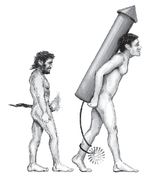
Evidence of a use for something once considered worthless is always cause for excitement, even celebration, in laboratories. Remember the appendix, poster child for vestigial structures? True, it no longer does the tasks that a herbivore’s appendix tackles. In koalas, for example, the organ is enormous and helps digest fibrous plant matter. But the fleshy tube may have a secondary use
9
as a holding pen for beneficial bacteria. The walls of the human appendix are coated in bacterial biofilms, and when sanitation is poor, the appendix can store and protect these good bacteria through bouts of diarrhea.
9
as a holding pen for beneficial bacteria. The walls of the human appendix are coated in bacterial biofilms, and when sanitation is poor, the appendix can store and protect these good bacteria through bouts of diarrhea.
The benefits of an appendix that stores good bacteria may be merely a happy side effect of an otherwise vestigial organ.
If the appendix, or a pseudogene, or even those silly ear-wiggling muscles turn out to be more useful than we suspected, it won’t be an unprecedented discovery. Perhaps the leg bones of whales now serve as diving ballast. After all, evolution recycles. The broken bodies of former genes are ripe for reuse, and obsolete organs can be molded for new work.
As we dig deeper into answering
“What does that thing do?”
we uncover not only new questions, but also elegant new chains linking us to our evolutionary heritage.
“What does that thing do?”
we uncover not only new questions, but also elegant new chains linking us to our evolutionary heritage.
CHAPTER 5
EXPLOSIONS: TICKING TIME BOMB
“Viva la muerte!”
Boom! Bang! Whoosh . . . !
Boys love toys that go
boom
, and true to form, we present myriad tales of bomb botches, dynamite disasters, carbide calamities, tobacco tragedies, and fuel fiascos. By some fluke, many explosions were not eternal rest bringers . . . this time!
Boys love toys that go
boom
, and true to form, we present myriad tales of bomb botches, dynamite disasters, carbide calamities, tobacco tragedies, and fuel fiascos. By some fluke, many explosions were not eternal rest bringers . . . this time!
Payback • Dynamite Rancher •
Carbidschieten
● A Really Bad
Carbidschieten
● A Really Bad
Commute • Anchors Away! • Killer Fuel Economy • Mortar Fire •
A Cushioned Blow • Homemade Howitzer • Nitrating the
Unknown • Against the Odds • Caps’n’Hammer Kid •
The Mettle of the Kettle • Boom Boom Bees
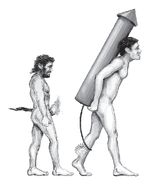
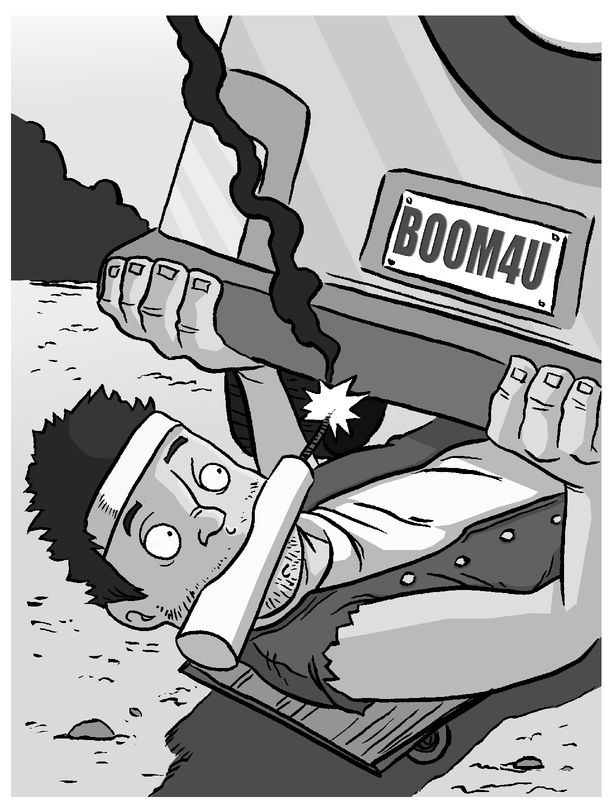
Confirmed by Darwin
Featuring criminals, money, and an explosion
—
Polonius, in
Hamlet
Polonius, in
Hamlet
27 DECEMBER 2008, SERBIA | Wanted in Croatia for murder and robbery of a post office, twenty-three-year-old Strahinja R. had good reason to leave the country. Fortunately for him, even bad guys have good friends. Aided and abetted by a friend who lent him 15,000 euros, Strahinja jumped the border and fled to Serbia, successfully evading prosecution.
Some loans can never be repaid. This was such a loan. Finding himself unable to earn or steal the funds needed to reimburse his benefactor, Strahinja attempted to end the matter in another way—by murdering him.
He crawled under his “friend’s” Jeep to plant a powerful Repayment-brand explosive. However, the muffler was still hot, and the heat set off the bomb while Strahinja was beneath the vehicle. He died in the hospital in the capital city of Belgrade, vividly illustrating the truth of Shakespeare’s warning, “Neither a borrower nor a lender be.”
Even bad guys have good friends.
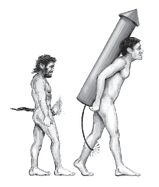
Confirmed by Darwin
Gun + dynamite = explosion
8 MAY 2009, UTAH | Fifty-nine-year-old Brent L. found a suspicious stash of dynamite in a shed on his five-thousand-acre ranch, located three miles south of the ATK Thiokol testing area where booster rockets for the space shuttle are designed. Details about this stash are scarce. Did it belong on the ranch? Was it hidden by thieves? Is it coincidence that the ranch is close to ATK Thiokol Ground Zero? Chief Deputy Potter said, “Whether the dynamite was his or whatever, that’s yet to be determined.”
Whatever its origins, the rancher was alarmed. He had good reason to worry. Old dynamite starts to sweat
nitroglycerine,
and once it starts it is unstable and can pop anytime. This well-known fact was surely known by the rancher. Fortunately the dynamite was not an old, sweating pile of unstableness. This stash of flash was something he felt he could deal with on his own.
nitroglycerine,
and once it starts it is unstable and can pop anytime. This well-known fact was surely known by the rancher. Fortunately the dynamite was not an old, sweating pile of unstableness. This stash of flash was something he felt he could deal with on his own.
“This stash of flash was something he could deal with on his own.”
Concerned for his family’s safety—but his own, not so much—the rancher removed the dynamite from the shed, placed it in a field of knee-high grass, grabbed his shotgun, and backed away about forty yards. One would like to think that he stopped to consider his next action, but the evidence suggests otherwise. He aimed and fired. Guess what?
Other books
Genesis by Christie Rich
When the Emperor Was Divine by Julie Otsuka
Jackson Hole Valentine by Cindy Kirk
Love and Fallout by Kathryn Simmonds
King Kobold revived-Warlock-2.5 by Christopher Stasheff
Mr. Pin: The Chocolate Files by Mary Elise Monsell
Tristan's Temptation by York, Sabrina
Short Stories: Five Decades by Irwin Shaw
Some Like it Easy by Heather Long
Banners of the Northmen by Jerry Autieri